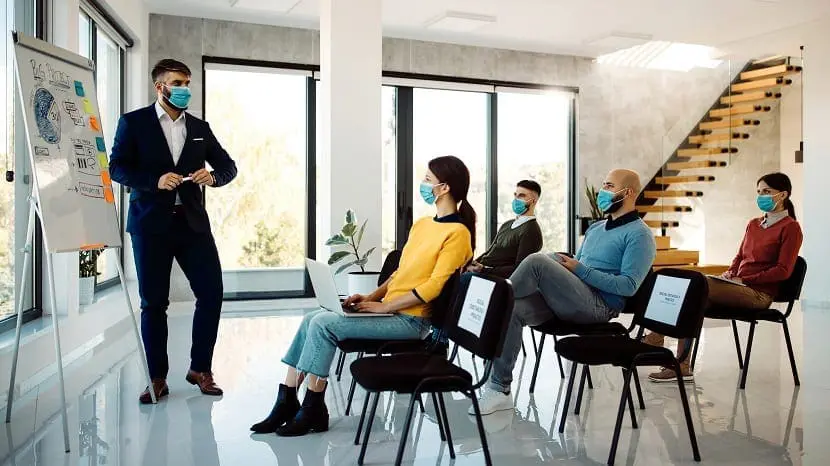Employee productivity and happiness has been on everyone’s minds over the past year. From “the Great Resignation” to “quiet quitting,” employee turnover continues to pose a challenge to organizations across the world.
One way to keep employees is to keep them safe. Organizations can do that by emphasizing and practicing occupational health.
Occupational health is a critical part of maintaining a healthy, safe, and productive workplace. It involves identifying and managing workplace hazards that can impact employee health and well-being and create a better sense of workplace wellness. That’s a key to minimizing employee absenteeism, increasing employee productivity, and improving the overall health and well-being of employees. When employees are healthy and happy, they are more likely to be engaged and productive at work, creating a positive work culture that is ripe for attracting and retaining top talent.
Let’s take a closer look at what occupational health is, how to implement and manage it, the risks it can help mitigate, and why it’s important for your organization.
Table of Contents
Occupational Health Definition
Occupational health is a multidisciplinary field that focuses on promoting and maintaining physical, mental, and social well-being in the workplace. This includes ensuring that employees are not exposed to harmful substances, noise pollution, or other hazardous conditions that can cause injury, illness, or disease. This can include anything from ensuring that employees have access to ergonomic equipment that reduces physical strain, to implementing stress management programs that promote mental health.
Furthermore, occupational health is not just about preventing negative health outcomes, but also about promoting positive ones. This can include providing health education to employees, encouraging healthy behaviors, and creating a culture of wellness within the workplace. It can also entail providing employees with access to ergonomic equipment that reduces physical strain and implementing stress management programs that promote mental health.
Importance of Occupational Health in the Modern Workplace

As companies look for ways to attract and retain talent, an increasing number of organizations are investing in occupational health programs. They know the benefits that a happy and safe workplace equals a more productive (and profitable) workplace.
These organizations are also acknowledging our current reality. The COVID-19 pandemic has caused a significant shift in the way workplaces operate, making it necessary for businesses to prioritize employee health and safety. By implementing occupational health measures, businesses can reduce the risk of COVID-19 transmission in the workplace and protect their employees. This not only keeps employees safe but also helps to mitigate the risk of business disruption due to outbreaks.
Additionally, investing in occupational health programs can have long-term benefits for companies. By promoting employee health and wellness, companies can reduce the cost of healthcare and improve the overall health of their workforce. This, in turn, can lead to increased productivity and profitability for the organization.
Four Categories of Occupational Health Risks
What are the risks that an occupational health program helps protect against? There are several, and they can be broadly categorized into four types: physical, chemical, biological, and psychological hazards.
Physical

Physical hazards can come in many forms, including noise, vibration, and extreme temperatures. For example, employees who work in noisy environments, such as construction sites, may be at risk of developing hearing loss over time. Similarly, employees who work in extremely hot or cold environments may be at risk of developing heat stroke or hypothermia. Physical hazards can also include slips, trips, falls, and other accidents resulting from unsafe working conditions.
Chemical

Chemical hazards can include exposure to toxic substances like asbestos, lead, and pesticides. Exposure to these substances can cause serious health problems, such as lung disease, neurological damage, and cancer. Employers must ensure that employees are aware of the risks associated with these substances and have access to the necessary protective equipment and training to minimize their risk of exposure.
Biological

Employees may be exposed to infectious agents like bacteria and viruses, which can lead to serious illnesses. It is important to provide your employees with the protective equipment, such as gloves and masks, to minimize their risk of exposure to these hazards. Employers must also ensure that employees are aware of the risks associated with biological hazards and take steps to minimize exposure.
Psychological

Psychological hazards can include workplace stress, bullying, and harassment. These types of risks can have a significant impact on employee mental health and lead to absenteeism, reduced productivity, and high turnover rates. It’s important to take steps to minimize these risks, such as providing employee assistance programs and promoting a culture of respect and inclusivity in the workplace.
Fortunately, there are many ways to manage occupational health risks, including conducting regular workplace inspections, providing appropriate training and education to employees, and implementing effective safety protocols. Additionally, it is important to establish a reporting system for workplace hazards so that employees can report any issues in a timely manner and appropriate action can be taken.
Occupational Health: Critical to Your Business and Employees
Occupational health is critical to the success of your business and employees’ well-being–and Acuity can help create the ideal occupational health program for your needs. Our occupational health services can be customized to any company and workforce, and are designed to protect employees, increase productivity, decrease healthcare costs, and reduce lost time.
Contact us to learn more about how to make occupational health a core part of your business.
What is Occupational Health: FAQ

What is the meaning of occupational health?
Occupational health refers to the promotion and maintenance of physical, mental, and social well-being in the workplace.
What is the main focus of occupational health?
The main focus of occupational health is to identify and manage workplace hazards that can impact employee health and well-being.
What are the four categories of occupational health?
The four categories of occupational health are physical, chemical, biological, and psychosocial hazards.
Why is occupational health important?
Occupational health is important because it helps to create a safe and healthy work environment for employees. This can lead to increased productivity, reduced absenteeism, and improved employee morale.
In conclusion, investing in occupational health is crucial to ensuring the well-being of employees and the success of a business. By prioritizing workplace wellness and implementing occupational health measures, businesses can create a safe and healthy work environment that benefits both employees and the company.
